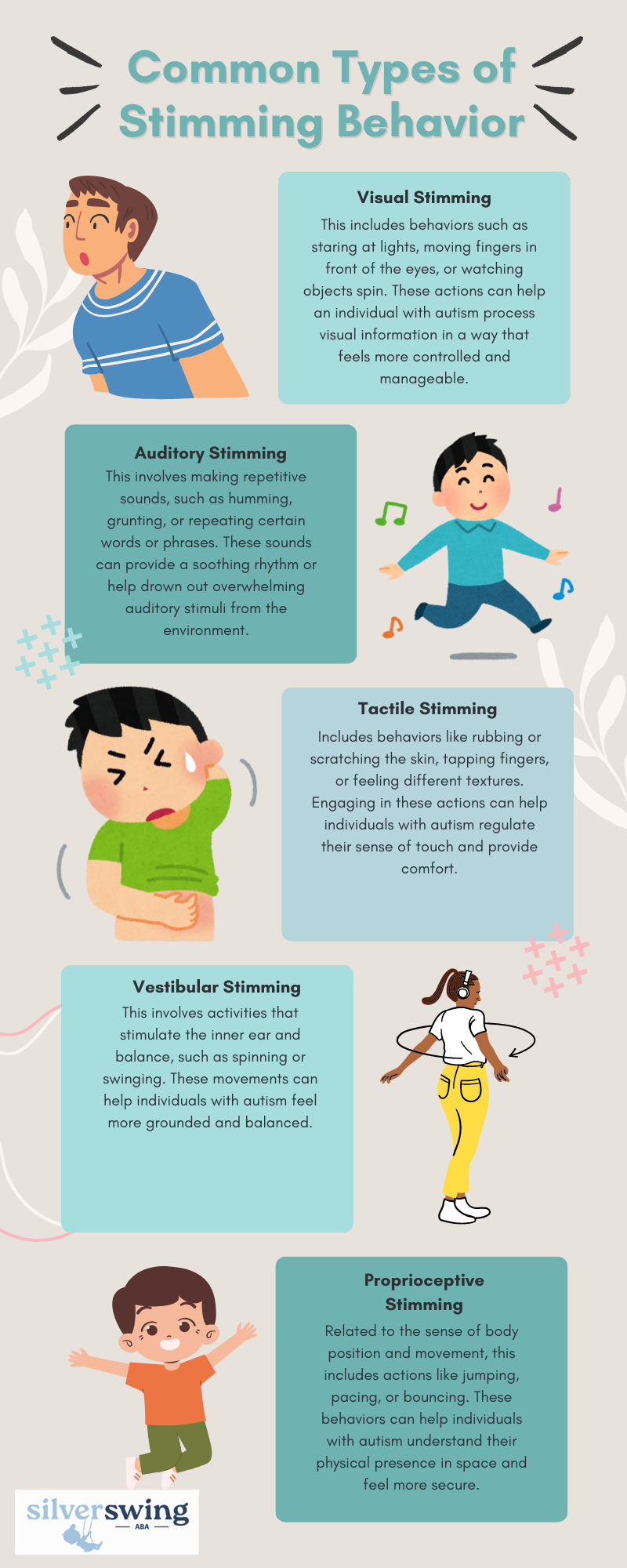Autism affects how individuals perceive the world and interact with others. One behavior often associated with autism is “stimming.” Short for self-stimulatory behavior, stimming involves repetitive movements or sounds.
In this article, we’ll delve into what stimming is, why it occurs, the different types, and how it can be managed or supported.

What is Stimming?
Stimming refers to repetitive movements or sounds that individuals with autism use to regulate their sensory experiences, manage emotions, or cope with stress. These behaviors can include hand-flapping, rocking back and forth, repeating words or phrases, or more subtle actions like finger-tapping.
Understanding stimming is crucial for appreciating the autistic experience and providing appropriate support.
It’s worth noting that stimming is categorized into different types. Here are the most common ones:

Why Do People Stim?
Stimming serves various purposes for individuals with autism. While it might appear unusual or disruptive to others, it is often a way for autistic individuals to cope with their environment. Let’s look at some common reasons why people stim.
Sensory Regulation
Many individuals with autism have sensory processing differences. They might be hypersensitive or hyposensitive to sensory inputs such as light, sound, touch, taste, and smell. Stimming can help them regulate these sensory experiences. For example, a person might flap their hands to block out overwhelming visual stimuli or hum to drown out noisy environments.
A study highlighted how stimming behaviors help manage sensory overload by providing predictable and controllable sensory input. This can be crucial in environments that are otherwise chaotic and overwhelming for individuals with autism.

Emotional Expression
Stimming can also be a way to express emotions. For instance, someone might stim more intensely when they are excited, anxious, or frustrated. It provides a physical outlet for their feelings and can help them manage their emotional responses.
One study that found a significant correlation between stimming behaviors and emotional states. The research showed that stimming could serve as an external manifestation of internal emotional experiences, allowing individuals with autism to communicate their feelings non-verbally.
Focus and Concentration
Some people use stimming to help them concentrate. Repetitive behaviors can create a sense of rhythm and predictability, making it easier for them to focus on a task. This is similar to how some neurotypical people might tap their foot or fidget with a pen when trying to concentrate.
Coping Mechanism
In stressful situations, stimming can serve as a coping mechanism. It provides a sense of control and comfort, helping individuals manage anxiety or stress. For example, rocking back and forth can have a calming effect during times of distress.
Research indicates that stimming behaviors can be a proactive strategy for managing stress. The study revealed that stimming helps individuals with autism maintain emotional equilibrium, especially in environments that they find challenging.

The Science Behind Stimming
Stimming is a natural behavior seen in many people, not just those with autism. However, it is more pronounced and frequent in individuals with autism. Researchers have conducted several studies to understand the neurological and psychological aspects of stimming.
Neurological Basis
A study found that stimming behaviors are linked to specific neural circuits in the brain. These circuits are involved in reward processing and sensory regulation. The study suggested that stimming activates these circuits, providing a sense of pleasure or relief.
Neuroimaging studies have shown that the activation of the brain’s reward system during stimming might explain why these behaviors are so persistent. The release of dopamine, a neurotransmitter associated with pleasure, reinforces the behavior, making it a self-rewarding activity for individuals with autism.
Psychological Factors
A research explored the psychological aspects of stimming. It found that stimming is often a response to emotional and environmental stressors. The study highlighted that stimming can be a self-soothing mechanism that helps individuals with autism manage their emotions and sensory experiences.
The psychological benefits of stimming are supported by behavioral studies that show a reduction in stress and anxiety levels when individuals engage in these behaviors. Stimming can create a buffer against overwhelming external stimuli, allowing individuals with autism to regain a sense of control and calm.

How to Support Individuals Who Stim
Understanding and supporting individuals who stim is crucial for their well-being. Here are some ways that parents and caregivers can provide support:
Acceptance and Understanding
The first step in supporting individuals who stim is to accept and understand their behavior. Recognize that stimming is a natural and necessary part of their experience. Avoid trying to stop or discourage stimming unless it is harmful.
Create a Supportive Environment
Creating a sensory-friendly environment can help reduce the need for stimming. This might include providing quiet spaces, reducing harsh lighting, and allowing the use of sensory tools like fidget toys or noise-canceling headphones.
Teach Alternative Coping Strategies
While stimming is a valid coping mechanism, it can be helpful to teach additional strategies for managing sensory overload and stress. This might include mindfulness techniques, deep breathing exercises, or other calming activities.
Professional Support
In some cases, professional support from occupational therapists or behavioral therapists can be beneficial. These professionals can work with individuals to develop personalized strategies for managing stimming and other behaviors.

Misconceptions About Stimming
There are many misconceptions about stimming, especially among those who are not familiar with autism. It is important to address these misconceptions to foster a more inclusive and understanding society.
Misconception 1: Stimming is Always a Problem
One common misconception is that stimming is always a problem that needs to be fixed. In reality, stimming is a natural and often beneficial behavior for individuals with autism. It only becomes a concern if it leads to self-injury or significantly interferes with daily activities.
It’s essential to distinguish between harmful stimming and benign stimming. Harmful stimming, such as head-banging or self-biting, requires intervention to ensure safety. However, benign stimming, like hand-flapping or humming, should be accepted as part of the individual’s self-regulation toolkit.
Misconception 2: Stimming is Unique to Autism
While stimming is more pronounced in individuals with autism, it is not unique to autism. Many people, including those who are neurotypical, engage in stimming behaviors such as tapping their foot, twirling their hair, or biting their nails. The difference lies in the frequency and intensity of these behaviors.
Understanding that stimming exists on a spectrum helps reduce stigma. Recognizing that everyone engages in some form of self-stimulatory behavior can foster empathy and acceptance for those whose stimming is more noticeable or frequent.

Misconception 3: Stimming Can Be Easily Controlled
Another misconception is that individuals can easily control their stimming behaviors if they try hard enough. However, stimming is often an involuntary response to sensory input or emotional stress. Expecting someone to simply stop stimming is unrealistic and can be harmful.
Efforts to suppress stimming can increase stress and anxiety, leading to more intense or frequent stimming behaviors. Instead, supportive approaches that address underlying sensory or emotional needs are more effective in managing stimming.
Stimming is a common behavior in individuals with autism that serves various purposes, from sensory regulation to emotional expression. While it might appear unusual to those who are not familiar with autism, it is an important part of many autistic individuals’ lives. Understanding and supporting stimming can help create a more inclusive and accepting society.
By recognizing the reasons behind stimming, dispelling misconceptions, and advocating for acceptance, we can better support individuals with autism and their unique needs. Stimming is not something to be feared or discouraged but rather embraced as a natural and necessary part of the autistic experience.
Sources:
https://www.research.chop.edu/car-autism-roadmap/stimming-what-is-it-and-does-it-matter
https://raisingchildren.net.au/autism/behaviour/common-concerns/stimming-asd
https://www.verywellhealth.com/what-is-stimming-in-autism-260034
https://www.webmd.com/brain/autism/what-you-need-to-know-about-stimming-and-autism




